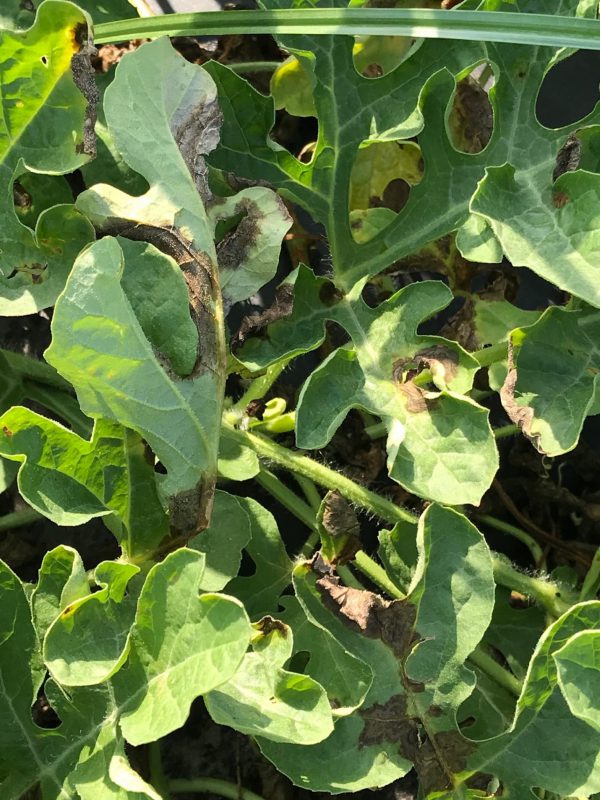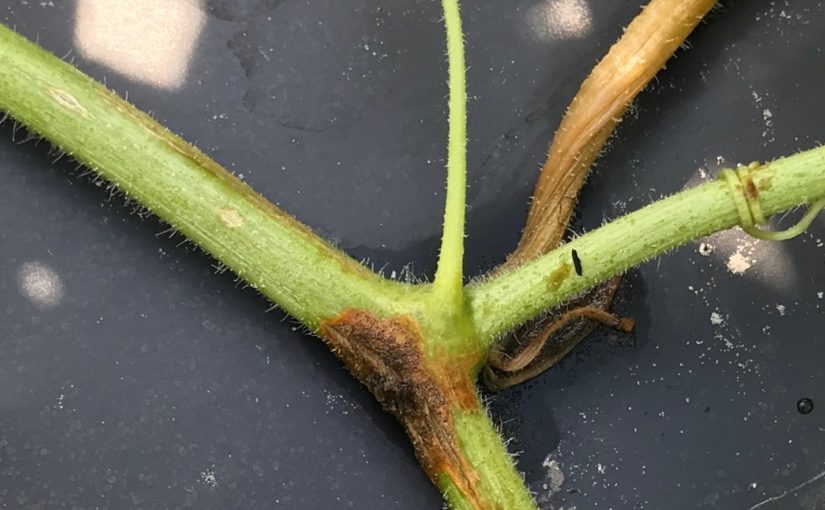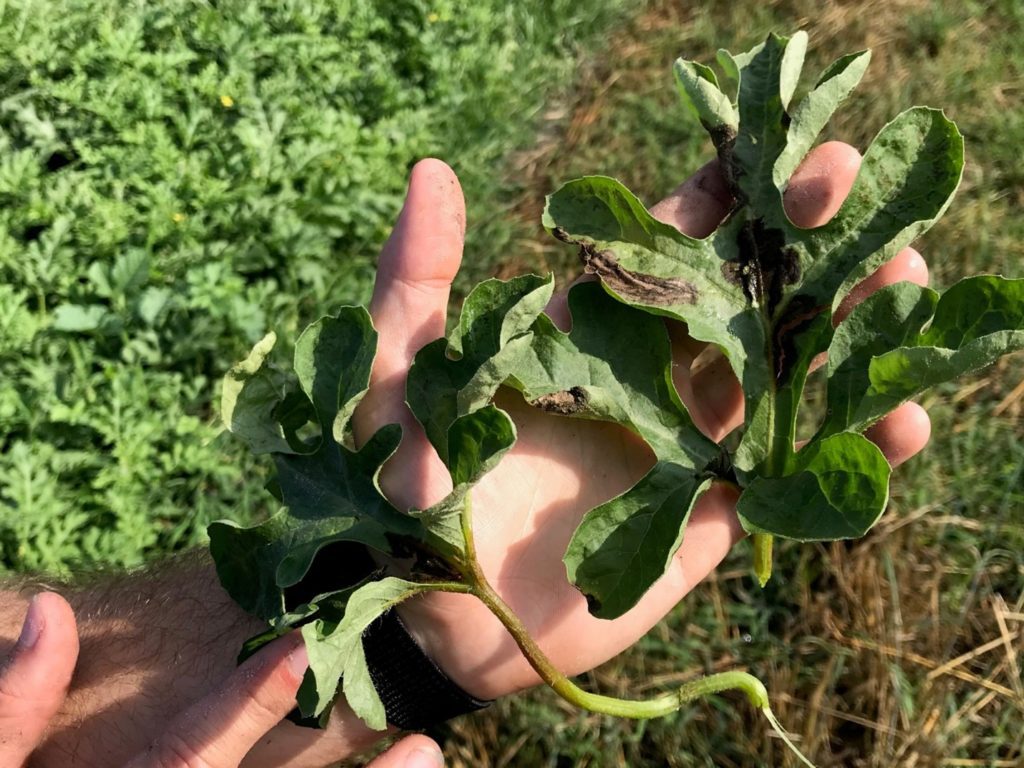May 21, 2021Watermelon crop update in Florida includes gummy stem blight warning
University of Florida, Institute of Food and Agricultural Sciences (UF/IFAS) Extension agents have issued an alert for watermelon farmers in the Suwannee Valley region about a potentially dangerous disease that could impact their crop.
Reports this week were frequent and it’s being confirmed quickly that we are undergoing high pressure from outbreaks of gummy stem blight. The high temperatures and higher humidity, along with rain showers in the region all seem to be providing the perfect environment for gummy to really take hold. Affected fields can be found throughout the region. In fact, I would be willing to bet we could find gummy infections in every field, if we looked hard enough.


Lesions can form on the stem that enlarge and girdle the main stem. Cracking is often visible on the stem, accompanied by gummy ooze. Cankers develop on the stem that can be red, brown, or black in color, and a red to amber gummy substance can exude from this region. Black fruiting bodies of the fungus (pycnidia, perithecia, or pseudothecia) are often visible on the infected leaves, stems, and fruits and serve in confirmatory diagnosis. Large, brown lesions from severe infections can form on areas of the leaves that retain moisture for long periods of time, such as around veins or leaf margins.
These symptoms are much very common now, and the difference between severe and milder symptoms in fields is whether either Miravis Prime or Inspire Super had already been sprayed prior to the last week. Where either Miravis Prime or Inspire Super, or both, had been sprayed recently, the gummy stem blight symptoms are reduced. If your fields have not received one or both of those sprays, we URGE you to apply an application of Inspire Super immediately, as soon as weather permits. Inspire Super was the top-rated fungicide in our UF/IFAS research trials.


If you apply Inspire Super, you can tank mix with certain other materials, but be careful. Youcan add Procure if you want extra protection against powdery mildew. We still have not confirmed any cases of powdery mildew in the Suwannee Valley area, but we suggest everyone keep scouting for it. Inspire Super will give some help on powdery mildew, but is mainly targeted at gummy stem blight. You can also tank mix insecticides Intrepid or Coragen with Inspire Super.
Do not add any surfactant, foliar fertilizers, or any other pesticide (especially those with an emulsifiable concentrate (EC)) to the tank mix with Inspire Super. Higher volumes of spray per acre and higher pressure will improve coverage and effectiveness controlling gummy, since the major symptoms are down low in the plant canopy. As with all sprays really, it is preferred not to spray in the hottest part of the day.
Watermelon field day recap
The main topic of the field day was our work with controlled release fertilizers (CRF). At this farm the field was divided into three sections. One was using the Watson’s regular conventional fertilizer program with some fertilizer in the bed and the remainder fertigated based on petiole sap test results. The other two sections received two different analysis CRF fertilizers from Harrell’s in the bed only. A small fertigation event (2-3 lbs of nitrogen and potash per acre) was implemented at planting time on all sections. No additional fertigations were implemented before the field day. If petiole sap tests suggest a small fertigation event may be justified on the CRF sections from this point forward, we will add single small events only as needed. Leaf tissue and petiole sap levels have been nearly identical in all three sections leading into last week.
There was some “brisk” discussion about irrigation management at the field day. The good news is that it got everyone’s attention and serious consideration of the topic. Since that night, we have had a fair bit of follow up discussion and the attendees were split, half indicating they agreed, and half indicating they disagreed with one comment regarding the maximum length of an irrigation event should be 90 minutes.
The context of that statement, as Charles Barrett indicated, was based on a higher flow tape of 0.45- 0.50 gallons per minute per 100 feet of tape. Many growers use a low flow tape of 0.22 gallons per minute per 100 ft. A discussion of length of duration of any one event without including the drip tape flow rate is certain to end up in a disagreement. And, I think that is what happened. In terms of water delivery, a 1.5-hour event at 0.45 gallons is equal to 3.0 hours at a flow of 0.22 gallons.
After this was thought through (after a cool down period), several growers who thought they disagreed with Charles, later understood and actually agreed. The lesson in all of this, we should never discuss irrigation events in time only. Everyone MUST know the flow rate of their drip tape to even get a ticket to the discussion. No knowledge of your tape’s flow rate….no ticket! Bottom line for me (Bob H), after digging a few hundred blue dye holes in watermelon crops over the past 20 years,…. Charles was “right on the money”, especially for early to mid-season events. I even had one grower indicate, with a 0.45 flow rate tape, he never goes over 1.0 hour, he just adds events in his automated system and can irrigate up to 4-5 times in a 24-hour period. The soil moisture sensors in those fields are picture perfect – no leaching. Late season events leading up to harvest are much less likely to leach and therefore, going above the recommended duration is not a crisis like it is early in the season.
Thanks to all who attended the field day last week at the farm of our gracious hosts, Greg and Dale Watson. Thanks also to Farm Credit for sponsoring the delicious meal.
Nutrient and irrigation management update
Most conventionally fertilized fields are at the stage of growth where the fertigation rates likely should be at 2.5 (at least 2.0 for any very young fields just setting fruit)) lbs per acre per day rate for nitrogen and potassium, using the net acres of watermelons in the field (not including drive middles and other non-cropped areas in the field). Some growers inject every day and others 2-3 times weekly. The math should be calculated on a weekly basis. For a 2.5 lbs per acre per day rate times 7 days equals 17.5 lbs over that week. Once we start harvests, it is common to set the rate at 2 lbs per acre per day, and leave it there until one week from last pick. This amount can be fine-tuned with the use of our petiole-sap testing program, offered as a service by Extension agents in this region. Water demands these past two weeks escalated with heavy fruit setting and sizing of the fruit. This is always anticipated, and the change is dramatic. Most fields are at or past the point when one irrigation event per day will do the job. A second or even third event are commonly being implemented. Hopefully, every farm has soil moisture sensors, and are using them to guide the number and duration of each event. Now, the concern will be keeping up with the demand.
Disease Update
We are beginning to see a few more disease reports this past week. Reports last week were pretty similar to the previous two weeks for fusarium wilt. The rate of new plants wilting has subsided as expected as the temperatures were high over the past two weeks. This slowing of new plants wilting is the same trend, whether treatments were implemented or not. That is just the way it is as temperatures increase.
Pseudomonas bacterial leaf spot seems to have slowed due to the dry weather conditions. Downy mildew has not been confirmed on watermelons in our region, so let’s hope it stays away this year. However, we are seeing significant increase in activity in a few fields from alternaria leaf spot and gummy stem blight. These are more common now, but we are not suggesting general sprays across the region. But where gummy stem blight is found, we suggest a targeted fungicide. Inspire Super is our top rated fungicide in our research trials.
We still expect to see more foliar diseases this week, so let your county agent know if you see new disease symptoms. Most everyone has started a preventative program for powdery mildew by now. If not, I highly urge you to do so! We had been suggesting Miravis Prime if no symptoms were present yet, or adding Quintec, or Procure to the mix with mancozeb. (Summary by Bob Hochmuth with input from specialists, county agents, and consultants in the field)
Rindworm alert
We have now received a few confirmations of rindworms feeding damage last week. Management strategies are much more complicated now due to new label restrictions to protect pollinators (that is a good thing). The better materials will include the higher labeled rates Intrepid or Coragen (as a spray only) which are also safe to pollinators. Do not use pyrethroids (bifenthrin, Asana, Lambda, etc.) for control of rindworms as there is a very high level of resistance to that class and they are very toxic to bees. It is much easier to prevent rindworms than to clean them up after they get started.
Thank You to the Suwannee Valley Rapid Diagnostic Watermelon Program and Its Industry Sponsors
UF/IFAS Extension agents have initiated a more formal way to support our watermelon growers with a rapid diagnostics system through Suwannee Valley Regional. This industry-funded program allows Extension Agents to submit and pay for watermelon grower plant disease and other diagnostic samples. This SV Rapid Diagnostic Watermelon Program will help us to get quicker diagnostic results and not have to charge the growers directly. Plant disease samples are typically $40 and leaf tissue analyses are typically $20. We want to thank the initial sponsors of this program: Syngenta Crop Protection, Harrell’s Fertilizer, Koppert Biological Systems, Seedway LLC, BASF Vegetable Seeds, Bayer Crop Science, Gowan Seed, and Gowan USA for sponsoring this effort.
Other industry reps interested in sponsoring this effort can contact Bob Hochmuth at [email protected] or 386-288-6301.
– UF/IFAS Extension Suwannee Valley Weekly Watermelon Crop Update. Summarized by Bob Hochmuth with input from Suwannee Valley Extension Agents: Mark Warren, Tyler Pittman, Tatiana Sanchez, Luke Harlow, Jay Capasso, Sylvia Wills, Dan Fenneman, Keith Wynn, Danielle Sprague, Kevin Athearn and Charles Barrett.
Photo at top: Gummy stem blight in watermelon. Photos: University of Florida















